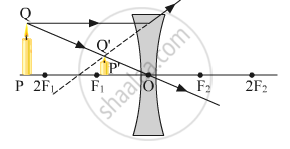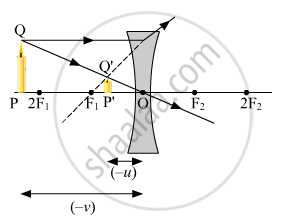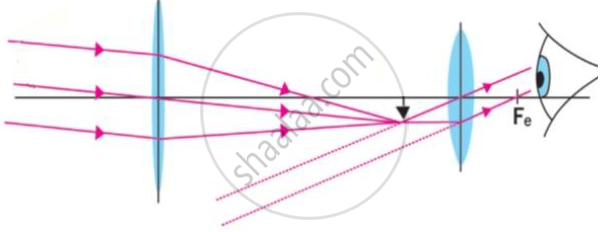Advertisements
Advertisements
प्रश्न
(a) Draw a ray diagram to show the formation of image by a concave lens when an object is placed in front of it.
(b) In the above diagram mark the object distance (u) and the image distance (v) with their proper signs (+ve or –ve as per the new Cartesian sign convention) and state how these distances are related to the focal length (f) of the concave lens in the case.
(c) Find the nature and power of a lens which forms a real and inverted image of magnification –1 at a distance of 40 cm from the optical centre.
उत्तर
(a)

(b) The object distance (u) and the image distance (v) are indicated in the figure given below.

Since both the image and the object lie in the direction opposite to the direction of the incoming ray, both will be negative. The relation between u, v and f given by the lens formula is
`1/f=1/v-1/u`
As both u and v are negative, the above equation will be changed to
`1/f=1/((-v))-1/((-u))`
`1/f=-1/v+1/u`
`1/f=1/u-1/v`
We know that the focal length of a concave lens is negative. Using the same argument, the above equation will be changed to
`1/-f=1/u-1/v`
`1/f=1/v-1/u`
(c) Given:-
u = −40 cm
m = −1
Since magnification is given as
`m=v/u`
`rArrv="mu "=(-1)xx(-40)=40" cm"`
Focal length can be calculated as
`1/f=1/v-1/u=1/40-1/((-40))=1/20`
`rArrf=20" cm"`
Now, the power of the convex lens can be calculated as
`P=1/f(m)=100/20="5 D"`
Since the power of the lens is positive, the lens will be converging in nature.
APPEARS IN
संबंधित प्रश्न
A student wants to project the image of a candle flame on the walls of school laboratory by using a lens:-
(a) Which type of lens should be use and why?
(b) At what distance in terms of focal length 'F' of the lens should be place the candle flame so as to get (i) a magnified, and (ii) a diminished image respectively on the wall?
(c) Draw ray diagram to show the formation of the image in each case?
A 1 cm high object is placed at a distance of 2f from a convex lens. What is the height of the image formed?
An object is placed at a distance equal to 2f in front of a convex lens. Draw a labelled ray diagram to show the formation of image. State two characteristics of the image formed.
Three convex lenses are available having focal lengths of 4 cm, 40 cm and 4 m respectively. Which one would you choose as a magnifying glass and why?
A convex lens produces an inverted image magnified three times of an object placed at a distance of 15 cm from it. Calculate focal length of the lens.
A student did an experiment with a convex lens. He put an object at different distances 25 cm, 30 cm, 40 cm, 60 cm and 120 cm from the lens. In each case he measured the distance of the image from the lens. His results were 100 cm, 24 cm, 60 cm, 30 cm and 40 cm, respectively. Unfortunately his results are written in wrong order.
What is the focal length of this lens?
Observe the following figure and answer the questions.

a) Which optical instrument shows arrangement of lenses as shown in the figure?
b) Write in brief the working of this optical instrument.
c) How can we get different magnifications in this optical instrument?
d) Draw the figure again and labelled it properly
Answer the following question.
List four precautions which a student should observe while determining the focal length of a given convex lens by obtaining an image of a distant object on a screen.
Find the odd one out and give its explanation.
Distinguish between:
Concave lens and Convex Lens
